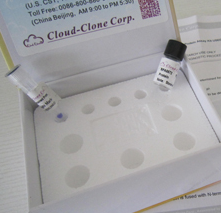
Substance P ELISA kitP物质
货 号:ADI-900-018
产品规格:96T
原 产 地:ENZO
参考价格:4990 (参考价格,以实际价格为准)
优惠价格:3996
产品详细信息
Substance P ELISA kitP物质 ADI-900-018 ENZO
Product Specification
Sensitivity: 8.04 pg/ml (range 9.76 – 10,000 pg/ml)
Assay Time: 3 hours
Application: For the quantitative determination of Substance P in culture supernatants, plasma, serum, saliva, and urine from any species. Cited sample type includes tissue (ref. 1).
Use/Stability: Store all components at 4°, except standard and conjugate at -20°.
Kit/Set Contains: GxR IgG Microtiter plate, Conjugate, Antibody, Assay buffer, Wash buffer concentrate, Standard, pNpp Substrate, Stop solution
Miscellaneous/General: Substance P is an undecapeptide hormone (RPKPQQFFGLM) that mediates a number of biological activities including nausea, anxiety, pain, and vasodilation. It is a member of the tachykinin family of neuropeptides, and is widely distributed in the peripheral and central nervous systems of vertebrates.
Product Literature References
Effect of anti-NGF antibodies in a rat tibia fracture model of complex regional pain syndrome type I : I. Sabsovich, et al. ; Pain 138, 47 (2008), (ref. 1), Abstract;
Endogenous ATP potentiates only vasopressin secretion from neurohypophysial terminals: J. Lemos, et al. ; J. Cell. Physiol. 217, 155 (2008), Application(s): EIA using rat culture supernatants, Abstract;
Tachykinin neurokinin 3 receptor signaling in cholecystokinin-elicited release of oxytocin and vasopressin: F. Flynn, et al. ; Am. J. Physiol. Regul. Integr. Comp. Physiol. 294, R1760 (2008), Application(s): EIA using rat plasma, Abstract;
Loss of Vav2 proto-oncogene causes tachycardia and cardiovascular disease in mice: X. Bustelo, et al. ; Mol. Biol. Cell 18, 943 (2007), Application(s): EIA using mouse plasma, Abstract;
Tachykinin NK3 receptor contribution to systemic release of vasopressin and oxytocin in response to osmotic and hypotensive challenge: G.E. Haley, et al. ; Am. J. Physiol. Regul. Integr. Comp. Physiol. 293, R931 (2007), Application(s): EIA using rat plasma (ref. 2), Abstract;
Urea transporter UT-A1 and aquaporin-2 proteins decrease in response to angiotensin II or norepinephrine-induced acute hypertension: J.D. Klein, et al. ; Ren. Physiol. 291, F952 (2006), Application(s): EIA using rat plasma, Abstract;
产品详细信息
Substance P ELISA kitP物质 ADI-900-018 ENZO
Product Specification
Sensitivity: 8.04 pg/ml (range 9.76 – 10,000 pg/ml)
Assay Time: 3 hours
Application: For the quantitative determination of Substance P in culture supernatants, plasma, serum, saliva, and urine from any species. Cited sample type includes tissue (ref. 1).
Use/Stability: Store all components at 4°, except standard and conjugate at -20°.
Kit/Set Contains: GxR IgG Microtiter plate, Conjugate, Antibody, Assay buffer, Wash buffer concentrate, Standard, pNpp Substrate, Stop solution
Miscellaneous/General: Substance P is an undecapeptide hormone (RPKPQQFFGLM) that mediates a number of biological activities including nausea, anxiety, pain, and vasodilation. It is a member of the tachykinin family of neuropeptides, and is widely distributed in the peripheral and central nervous systems of vertebrates.
Product Literature References
Effect of anti-NGF antibodies in a rat tibia fracture model of complex regional pain syndrome type I : I. Sabsovich, et al. ; Pain 138, 47 (2008), (ref. 1), Abstract;
Endogenous ATP potentiates only vasopressin secretion from neurohypophysial terminals: J. Lemos, et al. ; J. Cell. Physiol. 217, 155 (2008), Application(s): EIA using rat culture supernatants, Abstract;
Tachykinin neurokinin 3 receptor signaling in cholecystokinin-elicited release of oxytocin and vasopressin: F. Flynn, et al. ; Am. J. Physiol. Regul. Integr. Comp. Physiol. 294, R1760 (2008), Application(s): EIA using rat plasma, Abstract;
Loss of Vav2 proto-oncogene causes tachycardia and cardiovascular disease in mice: X. Bustelo, et al. ; Mol. Biol. Cell 18, 943 (2007), Application(s): EIA using mouse plasma, Abstract;
Tachykinin NK3 receptor contribution to systemic release of vasopressin and oxytocin in response to osmotic and hypotensive challenge: G.E. Haley, et al. ; Am. J. Physiol. Regul. Integr. Comp. Physiol. 293, R931 (2007), Application(s): EIA using rat plasma (ref. 2), Abstract;
Urea transporter UT-A1 and aquaporin-2 proteins decrease in response to angiotensin II or norepinephrine-induced acute hypertension: J.D. Klein, et al. ; Ren. Physiol. 291, F952 (2006), Application(s): EIA using rat plasma, Abstract;


